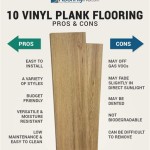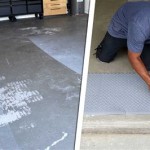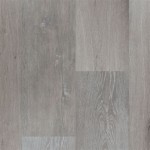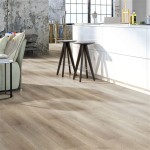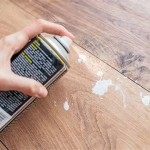How to Remove Tape Residue From Wood Floors
Tape residue on wood floors is a common nuisance. Whether left behind by masking tape, packaging tape, or even duct tape, the sticky remnants can be unsightly and difficult to remove. The adhesive interacts with the wood's surface, creating a bond that requires specific techniques to break down without damaging the floor's finish. This article provides a comprehensive guide to safely and effectively removing tape residue from wood floors, covering various methods and preventative measures.
The success of any tape residue removal method hinges on understanding the type of tape used, the age of the residue, and the type of finish on the wood floor. Some finishes are more delicate than others, and certain adhesives respond better to specific solvents or techniques. Attempting to remove residue without proper assessment can lead to scratching, discoloration, or even complete removal of the floor's protective coating.
Key Point 1: Assessing the Residue and Floor Type
Before commencing any cleaning process, a thorough assessment is crucial. The first step involves identifying the type of tape that left the residue. Different tapes utilize different adhesives, with varying degrees of stickiness and chemical composition. Masking tape, for example, generally leaves behind a less aggressive residue than duct tape, which contains a strong adhesive often reinforced with fabric.
Next, consider the age of the residue. Fresh residue is typically easier to remove than residue that has been present for an extended period. Over time, the adhesive can harden and become more deeply embedded in the wood's pores. Older residue may also have attracted dirt and grime, further complicating the cleaning process.
Finally, the type of wood floor finish is a critical factor. Common wood floor finishes include polyurethane, varnish, lacquer, and oil-based finishes. Polyurethane and varnish are generally more durable and resistant to solvents, while lacquer and oil-based finishes are more susceptible to damage. Understanding the finish type allows for the selection of appropriate cleaning agents and techniques that minimize the risk of harm.
A simple test in an inconspicuous area can help determine the floor's reaction to a chosen cleaning solution. Apply a small amount of the cleaner to a hidden spot, such as under furniture or in a closet. Observe the area for any signs of discoloration, softening, or damage to the finish. If no adverse effects are observed after a few minutes, the cleaner is likely safe to use on the affected area.
Key Point 2: Effective Removal Methods
Several methods can be employed to remove tape residue from wood floors, ranging from simple mechanical techniques to the use of solvents. The choice of method depends on the severity of the residue, the type of tape, and the floor's finish.
One of the gentlest approaches is using a plastic scraper or a credit card. Carefully angle the scraper and gently push under the edge of the residue. Avoid applying excessive pressure, as this can scratch the floor. Work slowly and methodically, lifting the residue in small sections. This method is particularly effective for removing large pieces of residue or relatively fresh adhesive.
Heat can also be used to soften the adhesive, making it easier to remove. A hairdryer set on low heat can be directed at the residue for a few seconds at a time. Avoid overheating the area, as excessive heat can damage the floor's finish. After heating, immediately attempt to scrape the residue away with a plastic scraper or credit card.
For more stubborn residue, solvents may be necessary. Mineral spirits, also known as paint thinner, is a common and effective solvent for removing adhesive. Apply a small amount of mineral spirits to a clean cloth and gently rub the residue. Avoid pouring the mineral spirits directly onto the floor. Allow the solvent to dwell for a few minutes to soften the adhesive, then wipe away the residue with a clean cloth. Always ventilate the area adequately when using mineral spirits.
Another option is using rubbing alcohol (isopropyl alcohol). Similar to mineral spirits, apply a small amount of rubbing alcohol to a clean cloth and gently rub the residue. Rubbing alcohol is generally less harsh than mineral spirits and may be suitable for more delicate finishes. However, it may not be as effective on tougher adhesives.
Commercial adhesive removers are also available. These products are specifically formulated to dissolve adhesive and are often effective on a wide range of tape residues. Always follow the manufacturer's instructions carefully and test the product in an inconspicuous area before applying it to the entire affected area. Some commercial adhesive removers may contain harsh chemicals, so it's essential to wear gloves and ensure adequate ventilation when using them.
For natural remedies, consider using a mixture of equal parts white vinegar and water. This solution can help soften the adhesive and make it easier to remove. Apply the mixture to a cloth and gently rub the residue. Alternatively, a paste made from baking soda and water can be applied to the residue. Allow the paste to sit for a few minutes, then gently scrub with a soft cloth.
After removing the residue, clean the area with a mild soap and water solution to remove any remaining solvent or cleaner. Dry the area thoroughly with a clean cloth. This step is crucial to prevent any water damage or discoloration to the wood floor.
Key Point 3: Preventing Future Residue Buildup
Preventing tape residue buildup is often easier than removing it. Several strategies can be implemented to minimize the risk of residue formation and make future removal easier.
When using tape on wood floors, opt for low-tack tapes specifically designed for delicate surfaces. These tapes use a less aggressive adhesive that is less likely to leave behind residue. Painter's tape, for example, is often a good choice for temporary applications.
Avoid leaving tape on wood floors for extended periods. The longer the tape remains in place, the more likely the adhesive is to bond with the floor's surface and leave behind residue. Remove tape as soon as it is no longer needed.
When applying tape, avoid pressing it down too firmly. Excessive pressure can force the adhesive deeper into the wood's pores, making it more difficult to remove later. Apply just enough pressure to ensure the tape adheres securely.
Consider using alternative methods for securing items to wood floors. For example, rugs can be secured with rug pads instead of tape. Furniture can be protected with felt pads instead of taping them in place.
Regular cleaning of wood floors can also help prevent tape residue buildup. Dusting and sweeping regularly removes dirt and debris that can become trapped in the adhesive, making it more difficult to remove. Periodically cleaning the floors with a mild soap and water solution can also help remove any lingering residue before it becomes a problem.
If tape is unavoidable, consider applying a protective layer to the wood floor before applying the tape. This can be achieved by applying a thin layer of wax or polish to the area where the tape will be placed. The wax or polish will act as a barrier between the tape and the floor, making it easier to remove the tape without leaving behind residue. However, it is crucial to test the wax or polish in an inconspicuous area first to ensure it does not damage the floor's finish.
Removing tape residue from wood floors requires patience, careful assessment, and the appropriate tools and techniques. By understanding the type of tape, the age of the residue, and the floor's finish, one can select the most effective removal method while minimizing the risk of damage. Implementing preventative measures can significantly reduce the likelihood of future residue buildup, preserving the appearance and integrity of wood floors.
Ultimately, consistent maintenance and proper usage of adhesives contribute to the longevity and beauty of wood flooring, ensuring they remain an attractive and durable feature of any home or building.

The Best Way To Remove Tape Residue From Hardwood Flooring Between Naps On Porch

The Best Way To Remove Tape Residue From Hardwood Flooring Between Naps On Porch

4 Ways To Remove Adhesive From A Hardwood Floor Wikihow

Best Cleaner Ever To Remove Sticky Tape From Floors Etc Safe Easy

The Best Way To Remove Tape Residue From Hardwood Flooring Between Naps On Porch

How To Remove Sticky Residue From Hardwood Floors

How To Remove Sticky Residue From Hardwood Floors

4 Ways To Remove Adhesive From A Hardwood Floor Wikihow

How To Remove Sticky Residue From Hardwood Floors Diy Hometalk

The Best Way To Remove Tape Residue From Hardwood Flooring Between Naps On Porch
See Also
